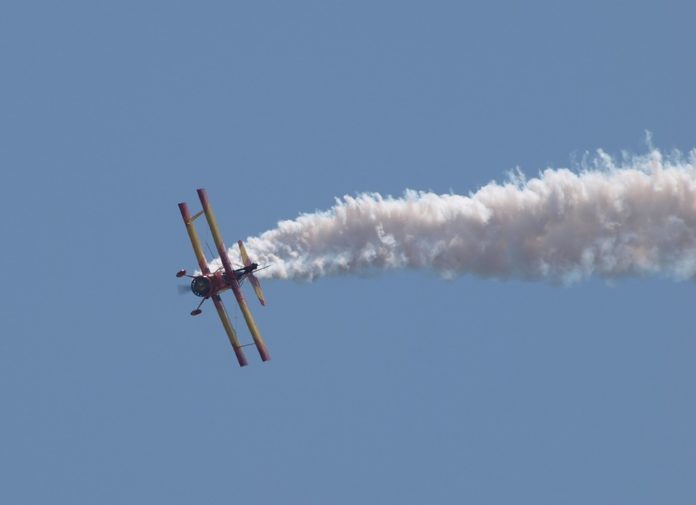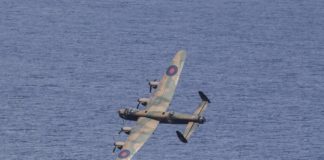Carl Clemens Bucker flew with the air service of the Imperial German Navy in World War One but subsequently went to Sweden for ten years and became managing director of Svenska Aero AB before returning to Germany in 1932. He founded Bucker Flugzeugbau at Berlin- Johannisthal in October 1933 along with engineering designer Anders Andersson from Svenska Aero.
In only six months the prototype Bu 131 Jungmann, D-3150, was built and flew on April 27, 1934. It had a welded steel-tube fuselage and tail assembly, all-wood wings, everything being fabric-covered except for metal sheeting on the engine cowling and the cockpit. An unusual feature was the interchangeability of upper and lower mainplanes, having aileron controls on all wing surfaces, a bonus for aerobatics. The engine was an 80hp Hirth HM.60K.
In demand
The Jungmann immediately attracted large orders and it became necessary to move production to a new factory in 1935, a site near Rangsdorf, south of Berlin, becoming the company’s base where all subsequent aircraft were produced. Initial production Jungmanns were Bu 131As, supplied to flying schools in Germany and to the nascent German Air Force which became the Luftwaffe in February the following year. Others were exported and in 1936 the Bu 131B with a 105hp Hirth HM.504 engine appeared and replaced the earlier model in production. To ensure uninterrupted training during the winter, Bucker developed new, short skis for use on the Jungmann, Jungmeister and Bestmann, and the two biplanes were still capable of aerobatics when wearing skis.
The Swiss Air Force evaluated the Bu 131B and bought six, A-1 to -6. Manufacture was then undertaken by the Swiss Dornier-Werke AG, the first ten being built by the end of 1936 with seven going to the Swiss Aero Club. Dornier built a further 78, A-7 to -84, while ten, A-85 to -94 were requisitioned from aero clubs.
The Jungmann served the Swiss Air Force from 1936 to 1971, and in the 1960s silencers were fitted.
Two were equipped in 1943 for blind¬flying training, in 1950 A-43 was fitted with an auto-pilot with remote control and five were equipped with glider-towing gear. In 1973 the 24 surviving aircraft were handed over to the Swiss Aero Club which had to sign an undertaking not to sell to foreign buyers for at The Jungmann served the Swiss Air Force from 1936 to 1971, and in the 1960s silencers were fitted.
Two were equipped in 1943 for blind¬flying training, in 1950 A-43 was fitted with an auto-pilot with remote control and five were equipped with glider-towing gear. In 1973 the 24 surviving aircraft were handed over to the Swiss Aero Club which had to sign an undertaking not to sell to foreign buyers for at the T-131 in 1937 for use by State aero clubs and had hoped for an order from the Czech Air Force but this did not materialise.
Wartime wings
Before World War Two began, Bucker had received substantial export orders for Jungmanns: 400 for Yugoslavia, Hungary 119, Bulgaria 15, Romania 40, South Africa 16, Brazil 19, Sweden 4, and two each for Uruguay, Chile, Finland, France, Holland, Poland, Portugal, with one for Australia. A 1938 demonstration tour of South America had been undertaken by a Jungmann and Jungmeister, while The Netherlands Indies Aero Fund bought six Jungmanns as trainers for flying clubs in June 1939.
Throughout the pre-war period deliveries were being made to the Luftwaffe flying schools and State organisations, with production reaching 1,000 by Autumn 1939. After the outbreak of war in September 1939 most Jungmann exports ceased except for 151 Bu 131Ds delivered to the Hungarian Air Force with minor improvements including a steerable tailwheel and uprated Hirth engine.
A 1938 demonstration in Japan by a Jungmann and Jungmeister resulted in purchase of the Jungmann and an order for a further 20 as the Navy Experimental Type Bu Primary Trainer (KX Bu 1). In 1942, Japan secured manufacturing rights and 339 were built by Watanabe (later renamed Kyushu) as the Navy Type 2 primary trainer Model built 61 K9W1s, while the Japanese Army was an even bigger user of Japanese-built Jungmanns; Nippon Kokusai Koku building 1,037 designated Ki-86 with 110hp Hitachi Ha-47 engines. Total Japanese production reached 1,376; all versions being given the Allied code name Cypress.
Post-war popularity
Total production of the Jungmann in Germany is quoted as 1,910, presumably this includes the 200 built by Aero in Czechoslovakia post-war.
Aero resumed production of a limited number retaining the Hirth engine and being designated C-4. Following a redesign, later models were fitted with the 105hp Walter Minor 4-III engine, the propeller turning in the opposite direction, these becoming C-104s with the Military Air The Jungmann was the outstanding two-seat aerobatic biplane.
Academy, the Air Training School and aero clubs. As they became surplus to military requirements, many C-104s were exported to American and European private owners and the Czech and Spanish-built Jungmanns represent the majority of survivors, but Switzerland still has over 40 on the civil register, mostly Dornier- built with a sprinkling of C-104s. Many of the former have been re-engined with a 180hp Lycoming IO-360 and re-named APM-131-150.
Some American examples have been re-engined with various types.
The Swiss-planned conversion to more powerful engines began in 1961 and the first two aircraft were converted by the Aircraft and Transport Works at Altenrhein, HB-UTH having ‘ |a 170hp Lycoming gained second place in the Lockheed Aerobatic Trophy Contest at Coventry in 1962, and was used by Hans Rudi Ruesch to become Swiss Aerobatic Champion in 1963. The next four conversions were undertaken by the Pilatus factory at Stans and by Datwyler at Langenthal- Bleinbach with 180hp Lycomings. They were HB-URN, ‘UPB, ‘URT and D-EDEF, formerly HB-ESA, this one going to the North-Rhine Westphalia Air Training College at Bonn.
For many years the Jungmann was the outstanding two-seat aerobatic biplane with a superior performance to its contemporaries, the Stampe SV4 and D.H. Tiger Moth. Eventually though, the fast and higher-powered Pitts took over until the later generation of monoplanes reigned, performing fantastic evolutions which the Buckers could not simulate, but if you want a slow, stately aerobatic routine the Jungmann is still around. Several are active in the UK and at least eight have appeared on the French vintage register in the F-AZ.. series, while a fair number are aiso flying in Germany and Switzerland and others in America.
In the past 20 years, new production of the Jungmann has begun in Poland by Serwis Samolstow Historyczynch (SSH) as the T-131P based on the Tatra/Aero version with a 105hp Walter Minor 4-III engine and the T-131PA with a 138hp LOM M.332AK. The prototype, SP-FPF, flew on July 8, 1994 followed by three pre¬production aircraft, while some 25 are said to have been built to date.
Enter the Jungmeister
The success of the Jungmann caused Bucker to consider a slightly smaller and more powerful single-seater as an advanced aerobatic trainer and the prototype Bu 133 Jungmeister, D-EVEO, was flown on August 21, 1935 by Luise Hoffmann, Europe’s first female works test pilot who was later to die in a Jungmann crash near Vienna in bad weather. Powered by a 140hp Hirth HM.506 inline engine, it proved excellent for aerobatics, making its first public appearance at a rally at Lausanne that year, where it was later tested by Walter Horning of the Swiss Aviation Authority. In 1936 it appeared at the International Aerobatic Championships held at its home airfield, Rangsdorf, but surprisingly attracted no orders with the Hirth engine.
Things were to change when the next two Jungmeisters, the only two Bu 133Bs, appeared with the 160hp Siemens-Bramo Sh-14A radial engine with the now characteristic cowling having bulges over the cylinder heads. They used around 40 per cent of parts of the Jungmann but had a slightly shorter span wing and fuselage length. The first Bu 131B was D-EAKE while the second, YR-PAX, was sold to Romanian aerobatic champion Alex Papana who took it to America aboard the airship Hindenburg and participated in air shows at the Cleveland Air Races in 1936-37. The German Aerobatic Championships in 1937, ’38 and ’39 were all won by pilots flying Jungmeisters, while similar success followed at the 1938 International Aerobatic Championships at Paris. During a South American demonstration tour in 1937-38, works test pilot Arthur Benitez twice crossed the 5,000m Cordillera mountains in the Andes in a Jungmeister, an impressive achievement in an open cockpit.
The definitive version of the Jungmeister was the Bu 133C which had a five-inch shorter fuselage and new elevators, and early examples were operated by civilian Luftsportsverband clubs and the Nationalsozialistisches Fliegerkorps flying schools for the growing Luftwaffe. By 1938 the Jungmeister had been chosen as the Luftwaffe’s main advanced trainer, although only 72 were received.
Aerobatic adventures
A flying day at Berlin-Tempelhof in 1937 saw Count Otto von Hagenburg in D-EEHO and two other pilots in D-EQOA and ‘JPE performing with the three aircraft tied together. Later, Hagenburg wrecked ‘EHO at the National Air Races in Cleveland in an ultra-low level inverted pass when he hit the ground, but suffering only a cut head he flew again later that day in Papana’s YR-PAX – Papana was obviously very trusting! Hagenburg also flew Jungmeister D-EFPR at the Cleveland event in 1938. Another well-known German aerobatic pilot was Liesel Bach, while something of a record must have been achieved at the 1939 Precision Flying Championships at Frankfurt when all 22 participants flew Jungmeisters!
A three aircraft aerobatic team, D-ESCS, ‘FPR and ‘WPH displayed at a Brussels show in 1938 while by 1939 this had grown to nine, then in Luftwaffe colours with a batch of serials beginning LG+01, deliveries having been made to three fighter schools and five general flying schools. This was the first aerobatic team of the Luftwaffe to appear outside Germany, but unfortunately one was lost in a fatal accident due to a sudden wind change. The team had 12 aircraft, with three in reserve.
Just before the outbreak of war, an unmanned Focke-Wulf Stieglitz was started up at Rangsdorf, hopped into the air and careered across the airfield. It removed the wing of a Heinkel He 46 and crashed into the doors of Bucker’s flight test hangar containing more than 50 aircraft, all new production models stored with their noses to the ground. The resulting fireball destroyed them and burnt out the hangar.
Nationalist Spain received 20 Jungmeisters in early 1937 serialled 35-1 to ’20, for the use of the Escuela de Transformation at Jerez de la Frontera. In 1941, CASA built 25 designated C.1133s with 160hp Hirth HM506 inline engines and the type survived in service until the 1960s when engine spares forced retirement. Romanian Prince Cantacuzene, a World War Two top scoring fighter pilot with around 60 victories against Russian and Allied aircraft became a leading aerobatic pilot in the 1950s with his modified Jungmeister EC-AEX.
Combat and colours
An early customer for the Jungmeister was the Swiss Air Force, its first six, U-51 to ’56, being German-built while a further 46 were built by Dornier at Altenrhein, U-49 and ’50, U-57 to ‘100. They were used for training and air combat exercises, for the latter being equipped with a camera-gun with built-in stopwatch, the dial of which was recorded on film to record the positions of the two aircraft. At the end of 1968 the Jungmeisters were withdrawn, their tasks taken over by Pilatus P-3s, some going to Swiss aero clubs, others for export while several were retained for Swiss museums. One civil example, HB-MKM ex U-89 was re-engined with a Lycoming, retaining a radial engine cowling and being christened Antares. No less than 40 former Swiss Air Force Jungmeisters were placed on the Swiss civil register, and at least 16 subsequently went to America.
Jungmeisters in America have appeared in a number of colours and a variety of engines, notably Frank Price’s N87P dubbed Super Jungmeister with a 200hp Lycoming and spats.
The latter also appeared on several German examples including D-EBZE and ‘NOW the latter owned by Fritz Ulmer as a Jungmeister Special which took part in 62 air shows between 1960 and 1970.
In the mid-1960s, American Jack Canary commissioned Josef Bitz to build Bu 133D-1s in co-operation with Wolf Hirth Flugzeugbau at Nabern-Teck and the first, D-EGZJ c/n 2001 flew on June 2, 1968 with Carl Bucker in attendance. It was demonstrated by Count von Hagenburg, then aged 67, who said “for me it was a pure pleasure”. The pre-war specification was followed, but using modern brakes and glassfibre engine cowlings. The first three completed were followed by airframes for a further nine, c/ns 2004-2012; the first being assembled by Wolf Hirth, while c/ns 2005, ’06, ’08 and ’09 were completed, ’06 and ’08 respectively becoming F-AZLB (later F-AZEU) and F-AZFIC in France and 2005 as D-EIKY in Germany.
Spain had intentions to build new Jungmeisters while a Polish company launched the T-133PA with a 160hp Siemens-Halske radial engine but nothing more seems to have come of either. Fortunately there are several of the originals still around but nothing is known of the whereabouts of the Canary versions.




